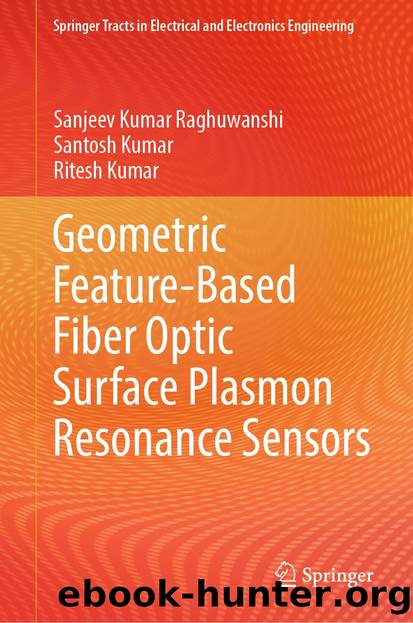Geometric Feature-Based Fiber Optic Surface Plasmon Resonance Sensors by Sanjeev Kumar Raghuwanshi & Santosh Kumar & Ritesh Kumar

Author:Sanjeev Kumar Raghuwanshi & Santosh Kumar & Ritesh Kumar
Language: eng
Format: epub
ISBN: 9789819972975
Publisher: Springer Nature Singapore
Esteban et al. (2011) have developed a method to manufacture tapered asymmetric single-mode fibers from ordinary silica fibers. These fibers are optimized for transmission at 850 nm. The resulting tapers have a waist diameter of 40 µm, a waist length of 12 mm, a total taper length of about 50 mm, and losses that are less than 0.2 dB. They deposited an Al/InN bilayer on these tapers using RF sputtering with a 2â³ confocal magnetron cathode (AJA International, ATC ORION-3-HV). This process was carried out at room temperature. This is the method that is most frequently employed for the development of optical coatings, which involves the deposition of nanocrystalline thin films onto a substrate. The aluminum layer was produced by heating an aluminum (Al) target using argon plasma while applying 75 W of DC electricity. When these conditions for growth were used, the rate of deposition that was produced was 2.8 nm per minute. For the InN experiment, the target was a disk made of pure In (4N5), while the reactive gas was made of pure N2 (6N). Plasma at a radio frequency was used to deposit the nitride at a power level of 40 W. The deposition was carried out at a working pressure of 3.5 mTorr throughout, whereas the initial pressure for it was on the order of 10â5 mTorr. Using these characteristics, they were able to build a number of sensors, each of which had an Al layer that was 8 nm thick but had a varied InN thickness, namely 40, 30, and 20 nm. The procedure for depositing has been carried out in a consistent manner. Therefore, the devices that were produced are what are referred to as âasymmetric onesâ. In these devices, only about half of the taper is covered by the bilayer structure, and the layer thicknesses vary across the device. A schematic representation of how the transducers were manufactured may be seen in Fig. 5.10. It is based on the measurement of the spectral transmittance of the devices through an OSA for various refractive indices of the outer media, and it is always done with the medium in liquid condition. As a result, the process begins with the measurement of the deviceâs transmission with air functioning as the surrounding medium; this measurement serves as the reference for the complete characterization. Because the results are spectrally based, a halogen lamp was utilized as the light source for this experiment. A polarization-controlling device that is based on a linear polarizer and a set of Lefèvre loops has been incorporated into the setup since the SPR phenomena in asymmetric tapers depend on polarization. However, polarization is not an issue with double-layer uniform-waist tapered fibers (DLUWTs) because polarization is not a factor in the SPR phenomenon. Because the authors of this research altered the polarization at the beginning of the tests to create the highest contrast possible, there is nothing further that has to be done to prevent any additional effect on the data. When the polarization
Download
This site does not store any files on its server. We only index and link to content provided by other sites. Please contact the content providers to delete copyright contents if any and email us, we'll remove relevant links or contents immediately.
Whiskies Galore by Ian Buxton(41722)
Introduction to Aircraft Design (Cambridge Aerospace Series) by John P. Fielding(33018)
Small Unmanned Fixed-wing Aircraft Design by Andrew J. Keane Andras Sobester James P. Scanlan & András Sóbester & James P. Scanlan(32686)
Aircraft Design of WWII: A Sketchbook by Lockheed Aircraft Corporation(32166)
Craft Beer for the Homebrewer by Michael Agnew(18084)
Turbulence by E. J. Noyes(7897)
The Complete Stick Figure Physics Tutorials by Allen Sarah(7268)
The Institute by Stephen King(6862)
Kaplan MCAT General Chemistry Review by Kaplan(6825)
The Thirst by Nesbo Jo(6765)
Bad Blood by John Carreyrou(6478)
Modelling of Convective Heat and Mass Transfer in Rotating Flows by Igor V. Shevchuk(6355)
Learning SQL by Alan Beaulieu(6161)
Weapons of Math Destruction by Cathy O'Neil(6087)
Man-made Catastrophes and Risk Information Concealment by Dmitry Chernov & Didier Sornette(5880)
Permanent Record by Edward Snowden(5684)
Digital Minimalism by Cal Newport;(5589)
Life 3.0: Being Human in the Age of Artificial Intelligence by Tegmark Max(5406)
iGen by Jean M. Twenge(5329)
